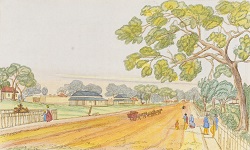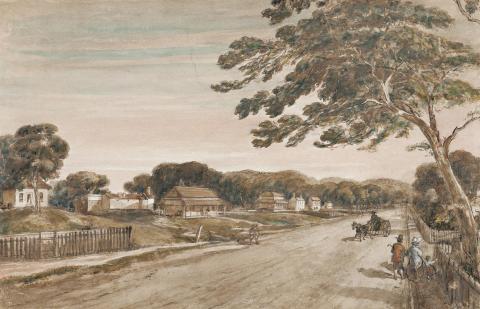SKETCH OF THE TOWN OF PERTH, WESTERN AUSTRALIA, c.1836 – 37
CHARLES DIRCK WITTENOOM
watercolour and pencil on paper
22.5 x 34.5 cm
bears inscription on label verso: C. D. Wittenoom / A STREET SCENE IN PERTH / … / Drawn circa 1832. / …
Captain Alfred Walter Frances Fuller, United Kingdom
Thence by descent
Mrs Estelle Fuller, United Kingdom
Sotheby’s, London, 30 January 1969, lot 93
Private collection
Christie’s, Melbourne, 3 May 1988, lot 99
Private collection, Perth
Various displays, Art Gallery of Western Australia, Perth, February 1989 – 2017
Unknown Land: Mapping and Imagining Western Australia, Art Gallery of Western Australia, Perth, 17 September 2016 – 30 January 2017 (as ‘Sketch of St. George’s Terrace, Perth’)
O’Brien, J. and Statham-Drew, P., On We Go: The Wittenoom Way – The Legacy of a Colonial Chaplain, Fremantle Press, Western Australia, 2009, pp. 46 – 47 (illus.)
Sketch of the Town of Perth, Western Australia, engraving by Henshall, J., illus. in Ogle, N., The Colony of Western Australia: a manual for immigrants, James Fraser, London, 1839, opposite p. 30 and Murdoch, W., Westralia Gift Book: to aid Y.M.C.A. military work and Returned Nurses' fund: by writers and artists of Western Australia, V. K. Jones, Perth, 1916, p. 40
Rev. John B. Wittenoom, Front View of the Artist’s House, 1832, pen and wash, 21.9 x 31.2 cm, in the collection of Art Gallery of Western Australia, Perth
St George’s Terrace is the main thoroughfare of Perth. Formerly cited as one of the most charming boulevards in Australia, it was utterly transformed by the mining booms of the 1960s and 1970s. After a kilometre of imposing skyscrapers, a section of colonial buildings still stands clustered around the Barrack Street precinct but these date predominantly from the years after convict labourers arrived in the 1850s. Going back even further to 1837, Charles Wittenoom stood some twenty metres back from that corner as he drew this historically important view of the young township, then known as the Swan River Colony. To the right is the entrance to what is now Barrack Street, so named for the army barracks which originally stood along the track that continues on the other side of the Terrace. In the foreground, where a mature Marri tree is depicted leaning over the road, was the residence of the artist’s brother Reverend John Burdett Wittenoom who had arrived in Perth in 1830 to take up the position as the colony’s Chaplain, a mere seven months after the Lieutenant-Governor, Captain Stirling, had arrived with the first settlers on the Parmelia.
As part of his contract, Reverend Wittenoom was given title to lot L1, ‘a narrow, deep allotment of about one acre on St George’s Terrace’,1 with Bazaar Street (now The Esplanade) as one of its boundaries. He soon bought the adjoining lot, which had a claypit. Leasing this to a brick maker in return for a tithe of 10,000 bricks, Wittenoom and his sons constructed a handsome two-storey house: ‘The bricks were made and burnt on the premises … The ‘tout ensemble’ looks exceedingly well and hath rather a genteel appearance than otherwise. It is much admired, being decidedly the most substantial and best built house in the colony’.2 He also planted a bountiful garden featuring a grove of thirteen peach trees. Wittenoom had formerly taught at Oxford University and augmented his theological duties in Perth by founding the colony’s first grammar school in 1838. He enthusiastically promoted the new colony in letters home, describing the climate as being ‘splendid and more congenial to health than any other on the face of the globe’;3 and became involved with the Children’s Friend Society, a charitable organisation based in London which found posts in the various British colonies for orphaned or abandoned children. It was this confluence of interests that led his brother Charles to travel to Perth, arriving in late December 1835.
CDC-10615246.jpg

Western Australia, 1839
National Library of Australia, Canberra
Already known as a sketcher and newspaper man, Charles chartered a small ship (the Giraffe) from London and brought with him ten children on behalf of the Children’s Friend Society.4 Four weeks later, he took the Giraffe on to Sydney where he stayed for a few months before charting another vessel, the Isabella, for a trading journey to the Dutch East Indies. Detained for a while in Timor, the Isabella returned to Sydney then continued to Perth, arriving 23 November 1836.5 This time Charles stayed for four months and it is almost certain that he completed this drawing during that period. In the early days of the colony there had been much speculation, but also much disappointment, fuelled by ‘get-rich-quick’ settler schemes proposed in London, most of which were undermined by dismal reports from returning ships’ captains who had deposited their passengers at the then-desolate tent city of Fremantle, some miles from the actual township of Perth. If the ships had journeyed further upstream, they would have found a more attractive and well-sheltered location described by its now-displaced indigenous inhabitants as ‘Nyungar boodjar, Nyungar land … [a river landscape created by] the Waakal or Dreamtime Serpent … weaving its bulky body across the plain, curving down to a wide path in front of The City of Perth, the bloated belly of a well-fed python’.6 Recognising the true potential of the new colony, the Wittenooms sought to change the misinformation being disseminated in England.
Sketch of the Town of Perth, Western Australia, c.1836 – 37 is one of only four known drawings executed by Charles Wittenoom whilst in the colony.7 Looking east down the Terrace, he depicted the principal buildings and made a feature of native trees which had been retained along the streetscape, augmented by flourishing introduced species. Riding toward the viewer in a stylish Stanhope gig is a figure identified by previous researchers as Reverend Wittenoom (in the absence of a visible clerical collar or scarf, it would seem this accreditation is based on the figure’s sober coat, tightly buttoned on a hot summer’s day). To the left, the hill gently inclines to the natural ridgeline that Hay Street now follows. The white-washed building shown is the original soldiers’ barracks (1829 – 30) with a roofed tent featuring striped canvas added as a side annexe. In front of this is the Officers’ Barracks built between in 1833, and further along, the Military Hospital (1831) bounded by Cathedral Avenue with the adjacent gaol (c.1829) at the corner of Pier Street. Opposite the Officers’ Barracks, visible between the trunk of the Marri tree and the edge of the drawing, is the small cottage, a ‘Palmer’s Hut’,8 which was Captain Stirling’s original home.9 Subsequently promoted to Governor and Commander-in-Chief, Stirling journeyed to London for a year in August 1832 and on his return10 found the original cottage too small for his needs, so took over the new Officers’ building for his family and as a Vice-Regal headquarters until a more appropriate Government House could be built.
The scene has all the warmth of a Perth summer and the bucolic air of pastoral commerce which would have communicated a clear and positive message to potential emigrants. Further evidence is the shadows, which are cast as if on a summer’s day in England, pointing to the north whereas in Perth, naturally, they face south. The message here is clear – Perth is presented as a genteel mirror of English society. Charles left the colony on 31 March 1837, a week after his brother opened ‘the new building erected to serve as both courthouse and church’. Still standing opposite the site of the Reverend’s own house, the Old Court House is central Perth’s only survivor from these foundation days.11 On arriving in London, Charles contacted Nathaniel Ogle, a Fellow of the Geological Society who had already published a range of books.12 It is almost certain that the two men knew of each other and may have even discussed Charles’ journey beforehand, as Ogle himself had been involved in an unsuccessful earlier proposal to found a colony south of Perth with ‘nearly 1000 well-selected companions to Leschenault and La Vasse’.13 Four of Wittenoom’s drawings were translated into engravings by J. Henshall and reproduced in Ogle’s highly influential The Colony of Western Australia: A manual for emigrants 1839, a richly detailed compendium which radically altered perceptions of the colony. In the engraved translation of Sketch of the Town of Perth, Western Australia, however, Charles appears to have suggested one distinctive addition – an enhanced view of Captain Stirling’s original dwelling peeking through the lush foliage. In addition, the original image of the Reverend in his horse-drawn gig was replaced with a dray, and the various street characters were augmented with a group of four aboriginal figures in European clothing.
Of the four original drawings executed by Charles, two are in Australian collections – Sketch of the Town of Perth from Perth Water, Western Australia (The Janet Holmes à Court Collection, Perth); and View from the Court House Arthur's Head, Freemantle [sic] (State Library of New South Wales, Sydney). The third remains in private hands, whilst examples of the engravings are held by various institutions and private collectors. Sketch of the Town of Perth, Western Australia was last offered for sale in 1988 when it achieved the then-record price of $93,500 for a Western Australian colonial drawing.14 There are other artist renditions of Perth and Fremantle from the 1830s but this particular work is unique with its aspect of St George’s Terrace as it appeared in its earliest inception 180 years ago.
1. O’Brien, J. and Statham-Drew, P., On We Go: The Wittenoom way. The legacy of a colonial chaplain, Fremantle Press, Western Australia, 2009, p. 25
2. Wittenoom, J.B., letter to cousin William Jersey, 24 July 1832, quoted in O’Brien, J. and Statham-Drew, P. op. cit., p. 26
3. ibid., p. 26
4. ‘Shipping Intelligence’, Perth Gazette and Western Australian Journal, Western Australia, 2 January 1836, p. 626
5. ‘Shipping Intelligence’, Perth Gazette and Western Australian Journal, Western Australia, 26 November 1836, p. 804
6. Collard, l. et al., ‘Oorl Ngulluck Koorliny (Come we walk together)’, in White, T.A. (ed.), Perth: a guide for the curious, UWA Publishing, Perth, 2016, p. 35
7. A fifth drawing, Front View of the Artist’s House, 1832 (Art Gallery of Western Australia), is attributed to Reverend Wittenoom but Charles is increasingly considered to be the most probable artist.
8. See Royal Perth Hospital Heritage Society website: http://rphheritagesociety.org.au/wordpress/wa-early-history/, accessed 13 July 2017
9. On the site of the contemporary Stirling Gardens, this building has been previously mis-identified by researchers as being Reverend Wittenoom’s house, but his was well out of this drawing’s frame, some thirty metres south of the mature Marri tree.
10. Stirling landed 19 August 1833, via the James Pattison.
11. Reverend Wittenoom’s house was demolished in 1890 and replaced by the Weld Club.
12. The Royal Geographical Society was founded in 1830 and the first paper read before the original members dealt with Western Australia.
13. Battye, J.S., Western Australia: A history of its discovery to the inauguration of the Commonwealth 1924 (facsimile edition), University of Western Australia Press, Perth, 1978, p. 78. The author thanks Janet Muir of Muir Old and Rare Books, Perth, for direction to this source.
14. Christie’s, Australian Paintings, Prints & Sculpture, Melbourne, 3 May 1988, lot 99
The author thanks Melissa Harpley and Eileen Jellis, Art Gallery of Western Australia, for assistance in cataloguing this work.
ANDREW GAYNOR
